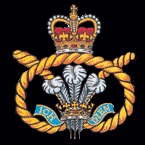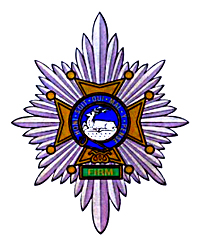
The Staffordshire Regiment (Prince of Wales') (or simply "Staffords" for short) was an infantry regiment of the British Army, part of the Prince of Wales' Division. The regiment was formed in 1959 by the amalgamation of the South Staffordshire Regiment and the North Staffordshire Regiment (Prince of Wales'), and in 2007 was amalgamated with the Cheshire Regiment and the Worcestershire and Sherwood Foresters Regiment to become the 3rd Battalion, Mercian Regiment.

The Mercian Regiment is an infantry regiment of the British Army, which is recruited from five of the counties that formed the ancient kingdom of Mercia. Known as 'The Heart of England's Infantry', it was formed on 1 September 2007 by the amalgamation of three existing regiments. The Regiment has had fifteen operational deployments since its formation.

The Cheshire Regiment was a line infantry regiment of the British Army, part of the Prince of Wales' Division. The 22nd Regiment of Foot was raised by the Henry Howard, 7th Duke of Norfolk in 1689 and was able to boast an independent existence of over 300 years. The regiment was expanded in 1881 as part of the Childers Reforms by the linking of the 22nd (Cheshire) Regiment of Foot and the militia and rifle volunteers of Cheshire. The title 22nd (Cheshire) Regiment continued to be used within the regiment.

The Worcestershire and Sherwood Foresters Regiment was an infantry regiment of the British Army, part of the Prince of Wales' Division. The regiment served as the county regiment for Derbyshire, Nottinghamshire and Worcestershire.
The Prince of Wales's Division was a British Army command, training and administrative apparatus designated for all land force units in the West of England and Wales. It merged with the Scottish Division, to form the Scottish, Welsh and Irish Division; at the same time the Mercian Regiment joined with the King's Division.
The West Midlands Regiment was a short-lived British Territorial Army regiment from 1999 until it was re-designated as 4th Battalion, Mercian Regiment, in 2007.
The Wessex Regiment was a Territorial Army infantry regiment of the British Army, in existence from 1967 to 1995. Initially consisting of a singular battalion, the regiment was later expanded to also have a second.

The Sherwood Foresters was a line infantry regiment of the British Army in existence for just under 90 years, from 1881 to 1970. In 1970, the regiment was amalgamated with the Worcestershire Regiment to form the Worcestershire and Sherwood Foresters Regiment, which in 2007 was amalgamated with the Cheshire Regiment and the Staffordshire Regiment to form the present Mercian Regiment. The lineage of the Sherwood Foresters is now continued by The Mercian Regiment.

The Worcestershire Regiment was a line infantry regiment in the British Army, formed in 1881 under the Childers Reforms by the amalgamation of the 29th (Worcestershire) Regiment of Foot and the 36th (Herefordshire) Regiment of Foot. The regiment fought in many conflicts, including both the First and Second World Wars, until 1970, when it was amalgamated with the Sherwood Foresters to form the Worcestershire and Sherwood Foresters Regiment. In September 2007, the regiment amalgamated with the Cheshire Regiment and the Staffordshire Regiment to form the Mercian Regiment.
The Mercian Brigade was an administrative formation of the British Army from 1948 to 1964. The Brigade administered the infantry regiments from the area of England between the Trent, Mersey and Severn rivers that roughly corresponded to the ancient kingdom of Mercia.

The North Staffordshire Regiment (Prince of Wales's) was a line infantry regiment of the British Army, which was in existence between 1881 and 1959. The 64th (2nd Staffordshire) Regiment of Foot was created on 21 April 1758 from the 2nd Battalion of the 11th Regiment of Foot. In 1881, under the Childers Reforms, the 64th Regiment of Foot was merged with the 98th (Prince of Wales's) Regiment of Foot (originally raised in 1824) to form the Prince of Wales's (North Staffordshire Regiment). In 1921 the regimental title was altered to the North Staffordshire Regiment (Prince of Wales's).

The Home Service Force (HSF) was a Home Guard type force established in the United Kingdom in 1982. Each HSF unit was placed with either a Regular Army or Territorial Army regiment or battalion for administrative purposes and given that formation's title, cap badge and recruited from volunteers aged 18–60 with previous British forces experience. It was introduced to guard key points and installations likely to be the target of enemy special forces and saboteurs, so releasing other units for mobile defence roles. It was stood down in 1992 due to budget cuts.
The 183rd Brigade was an infantry brigade formation of the British Army in both World Wars
The Light Infantry Volunteers was a short lived Territorial Army infantry regiment of the British Army, that existed from 1967 to 1972, composed of companies from the Light Infantry regiments. In 1972, it was re-designated as 5th Battalion, The Light Infantry, serving as such until amalgamation in 1999.
The 4th (Volunteer) Battalion, The Worcestershire and Sherwood Foresters was a former territorial infantry battalion that existed for a short time towards the end of the Cold War. Following reductions to the Territorial Army (TA) in 1992, the battalion was disbanded with elements helping to form RHQ & HQ Sqn of 37 Signal Regiment, and 96 Signal Squadron. This squadron was then reduced to a signal troop in 2009, but continues to exist as part of 48 Signal Squadron.
The 3rd (Volunteer) Battalion, Staffordshire Regiment was a Territorial Army unit of the regular Staffordshire Regiment which was formed in 1988, but disbanded in 1999. The battalion's successor continues to serve in the Mercian Regiment to this day.
The Light Infantry and Mercian Volunteers was a short-lived infantry regiment of the British Army, in existence from 1971 to 1975.

The 3rd (Volunteer) Battalion, Cheshire Regiment was a part-time infantry battalion based in Cheshire, England and tasked with home defence during its tenure. The battalion was formed in the latter part of the Cold War, but later disbanded forming two companies in the new local Territorial Army (TA) regiment, the King's and Cheshire Regiment. Today, the battalion's lineage is continued in Mortar Platoon, B Company, 4th Battalion, Mercian Regiment.

The Worcestershire Rifles was a volunteer, part-time unit of the British Army based in the county of Worcestershire which had a long, yet split history in two units before merging into the larger Worcestershire Regiment. Following active service in both World Wars, during which its strength was doubled into three battalions, the unit was reduced to a company, and later expanded to two companies. Following reductions in the early 21st century, the two companies were merged and later reduced to a platoon in 2006. Today, the regiment's lineage is continued in the anti-tank platoon of the 4th Battalion, Mercian Regiment, still based in Kidderminster where the first volunteers had formed.








